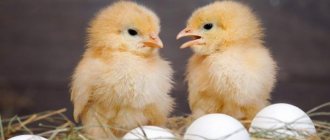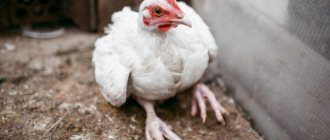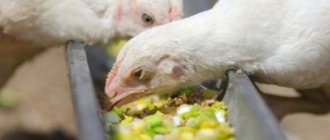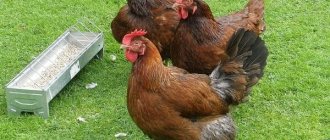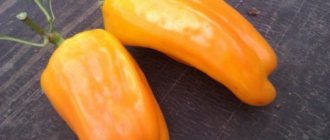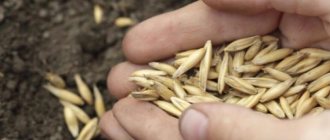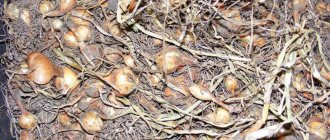Homestead farms account for about a third of the eggs and poultry meat produced in the country. Part of the production is consumed by the owners, and the surplus is sold in markets. Recently, highly productive breeds, lines and crosses have been used in home poultry farming. And together with some elements of industrial technology, such as cages for keeping birds, incubators for producing chickens on a conveyor belt, it has become quite a profitable business and brings good profits. This is especially true for raising broilers, because they gain weight quite quickly. Among the most popular is Cobb 500. Because its content is no different from other broilers, but its carcass is yellow. And this makes it stand out among other hybrids, which means that demand in the market will be higher. But to obtain carcasses of good presentation, broilers must first be raised. We will look at how to do this in this article.
Breed characteristics
According to the characteristics, the Cobb 500 hybrid was bred in the Czech Republic. It was obtained by crossing different meat and meat-egg breeds. The main goal was to achieve rapid weight gain with minimal feed consumption. Egg production was not taken into account, so these chickens are not raised for eggs.
Participated in the creation:
- Cornish variety (a hybrid of fighting breeds - Azil, British and Malay)
- Plymouthrock (American meat-egg variety)
- Kuchinsky Jubilee (universal breed, whose homeland is Russia)
- Zagorsk salmon chickens (another domestic universal breed with beautiful salmon plumage)
- Pencerevskaya (meat-egg breed, popular in homesteads)
- Rhode Island (classic meat-egg breed from the USA)
- New Hampshire (American chickens for meat and egg production)
- May Day chickens
All breeds that were used to create the cross have a universal direction. But during selection, lines with predominantly meat qualities were isolated. Experiments are currently being conducted to include new varieties of chickens in hybridization.
Several crosses with similar characteristics have already been obtained. For example, Ross-308, Ross-708, Cobb-700. The difference between Cobb 500 and Cobb 700 and other similar hybrids is that it is unpretentious in food, feed costs per unit of weight are much lower, which makes breeding more profitable.
Appearance
Description of the Cobb 500 chicken breed:
- Massive physique
- Thigh strong, muscular
- Legs are tall and thick
- The feather is white, without spots or inclusions of a different color
- The comb and earrings are small and scarlet
- The face is red, with thin integumentary skin
- The skin on the body is naturally yellow, which improves the quality of the carcass
Deviations from the standard include thinness, short legs, poorly developed hips, yellowish plumage or inclusions of other colors.
According to the description, day-old Cobb broilers 500 sucklings are not similar to adult birds. When purchasing them, pay attention to the color of the down; it should be light yellow, evenly colored. Broiler chicks are large, on high legs. All individuals in the batch are approximately the same weight and size, active, with a good appetite.
Description of the appearance of the Cobb 500 hybrid
Cobb broiler chickens are distinguished by their large build. They have a natural light yellow color of down, which becomes snow-white plumage as they grow.
Description of the Cobb 500 broiler:
- massive build with high and powerful paws;
- wide back and chest;
- a massive beak stands out on a medium-sized head;
- a small comb of rich red color;
- red earrings;
- the plumage is snow-white and dense;
- the wings are small, adjacent to the body;
- small raised tail.
Cobb 500 birds are not aggressive, calm, rarely make noise, and not pugnacious.
Deviations in the Cobb 500 species are considered to be: short legs, underdeveloped hips, thinness, yellowish shades of plumage and other inclusions.
At a certain stage of selection, cobbs acquired the dwarfism gene, which is why small-sized individuals are possible in the flock. Birds with such changes are culled.
Productivity
When buying Cobb 500 broilers for growing, first of all, pay attention to their productivity.
The most intensive period for the growth of broilers is 20 - 40 days, at this moment it is important to provide it with adequate nutrition
The main indicators for broiler hybrids are the weight of the young at 20-40 days and the rate of weight gain. Cross Cobb 500 weighs approximately 2 kg at 30 days, 2.5 kg at 40 days, and more than 3 kg at 60 days. If you keep the bird for up to 90 days, the carcass will weigh 4.5-5.5 kg. Further rearing is unprofitable; chickens recover slowly, while consuming a standard amount of feed.
For a better understanding of growth characteristics, it is recommended to use the Cobb 500 growth chart:
| Age | Weight (g) | Weight gain per day | Feed conversion | Feed consumption per individual per day | Total feed costs at a given time |
| 0 | 40 | ||||
| 10 | 260 | 25 | 0,940 | 40 | 245 |
| 20 | 775 | 40 | 1,235 | 100 | 955 |
| 30 | 1570 | 52 | 1,495 | 170 | 2350 |
| 40 | 2455 | 60 | 1,720 | 200 | 4220 |
| 50 | 3245 | 65 | 1,925 | 205 | 6245 |
| 60 | 3645 | 65 | 2,045 | 200 | 7450 |
Feed conversion is understood as its cost per unit of weight gain. For example, to obtain 1 g of live weight of a 1 month old broiler, you need to spend 1.5 g of feed. The lower the indicator, the more profitable it is to raise poultry and the breeding fully pays for itself.
The weight of the Cobb 500 broiler will increase by day if you keep males and females separately. This can be seen if we compare the norms in birds of different sexes.
Cobb 500 breed growth chart:
| Age | Weight (g) | Weight gain per day | Feed conversion | Feed consumption per individual per day | Total feed costs at a given time |
| 0 | 40 | ||||
| 10 | 250/270 | 25/30 | 0,955/0,930 | 38/40 | 240/250 |
| 20 | 740/815 | 40/50 | 1,250/1,215 | 95/105 | 920/990 |
| 30 | 1475/1670 | 50/55 | 1,525/1,465 | 160/175 | 255/2440 |
| 40 | 265/2645 | 55/65 | 1,75/1,655 | 185/210 | 4015/4405 |
| 50 | 2930/3570 | 60/70 | 2,010/1,835 | 185/215 | 5885/6545 |
| 60 | 3235/4055 | 60/75 | 2,155/1,925 | 180/210 | 6975/7810 |
The indicators given in the table may change in each specific case. They largely depend on the feed and growing conditions.
Recommendations from experienced poultry farmers
Thanks to the experience of farmers who have been growing this particular breed for many years, we can draw up a list of recommendations that will help avoid the most common mistakes:
- Food and water should be lukewarm, as cold foods are difficult to digest.
- When organizing the nutrition of birds for slaughter, the emphasis is on protein-containing feed, but laying hens need more greens.
- Since there is practically no walking, broilers do not need to organize ash baths; fine sand scattered on the floor is sufficient.
- If you plan to raise birds in winter, you should prepare vegetables for feeding. They are dried and simply soaked before being placed in feeders.
Care and maintenance of broilers
Cages or closed poultry houses are suitable for keeping Cobb 500 broilers.
There should be no more than 35-40 kg of live weight of birds per 1 m². For floor maintenance, a mesh floor with a small cell size is suitable. A mixture of sawdust, shavings and straw mixed with lime is used as bedding. It is important to change the litter on time and keep the chicken coop clean.
Cobb 500 broilers are highly sensitive to low temperatures. The poultry house should not be colder than 14⁰C. But this temperature is not ideal; the herd grows worse.
It is recommended to keep them warm, at 25⁰С-30⁰С and humidity 60-70%. Lighting in the first 2 weeks is 24 hours a day. From the 14th day it is reduced by 1 hour daily until the indicator is reached 16-18 hours. The light should not be too bright.
Chickens of the Cobb 500 hybrid are prone to cannibalism; in bright light, weak individuals begin to be pecked by strong ones.
Drinkers and feeders are installed under the walls. If the bird grows in cages, they are attached to the outer wall. When feeding with compound feed, one container for food and one for water is enough. If the diet includes wet mash, separate dishes are provided for them. You need to change the water twice a day. It is advisable to wash feeders and drinkers daily.
Growing rules for beginners
Cobb 500 broller chickens are becoming increasingly popular: raising them is so simple that even a beginner can handle it
However, it is important to provide quality care for birds
Optimal conditions, temperature conditions
You can choose one of two maintenance methods - cage or closed poultry house. Calculation of room area - per 1 sq. m. no more than 30 kg of live weight.
To decorate the floor, use a mesh with a fine mesh, a bedding made of sawdust, shavings, and straw. The top layer of litter is periodically updated, replacing it once a year in the summer.
The temperature regime is not lower than +14 degrees, Cobb 500 birds are very susceptible to cold. However, for the fastest possible weight gain, it is recommended to maintain a temperature of +25 degrees. Additional recommendations:
- For the first 14 days of life, Cobb 500 chickens need 24 hours of light.
- Gradually, the indicator is reduced by an hour, reaching 16 hours.
- The lighting should not be bright, otherwise the birds become aggressive and may start pecking.
Compliance with maintenance recommendations is a guarantee that birds will not engage in cannibalism
Features of feeding and care
It is allowed to give cobbs 500 wet mash or ready-made feed. Birds should always have access to clean water, and drinkers and feeders should be washed every day. For beginning breeders, the easiest option is to use mixed feed, but it is also possible to create your own diet.
Feeding self-prepared food gives less rapid weight gain, but is also used on farms. Good enough food for Cobbs 500 includes:
- wheat;
- barley;
- feed yeast;
- corn;
- ground grass;
- meat and bone and fish meal.
Note! Weight growth is well stimulated by corn; when preparing a feed mixture for fattening, its percentage is 50%. If wheat is included in bird feed, they absorb phosphorus less well, so they need an appropriate mineral supplement
If birds' food includes wheat, they absorb phosphorus less well, so they need an appropriate mineral supplement.
Broiler feeding
The weight of Cobb chickens 500 and the characteristics of their weight gain are directly related to the quality of nutrition. Most poultry farmers recommend using ready-made feed. It is when they are consumed that all the qualities of the hybrid appear and in 1-1.5 months a full-fledged bird is obtained, ready for slaughter.
The broiler menu differs from the laying hen diet primarily in its increased protein content, and protein-rich foods should also be added to the menu
Compound feed consists of a mixture of grain, fiber and high protein components. Vitamins and minerals must be added to it. In order for chickens to grow quickly, their diet should consist of 17-20% proteins of plant and animal origin. All components of finished feed are precisely calculated and balanced; entire scientific laboratories are working on their creation.
Compound feed is selected depending on the age of the chicken:
- 0-10 days – “Start”. This is crushed feed that is easily digested by chicks and contains a large amount of protein.
- 1-2 days – “growth”. This mixture contains a high percentage of proteins important for muscle growth and weight gain, as well as calcium for strengthening the skeleton. It is enriched with vitamins and minerals.
- 23 days until slaughter – “Finish”. In the final phase, the calorie content of the feed increases due to an increase in the content of starch, fiber, and fat. The amount of protein decreases slightly.
Sometimes in the first days Prestart feed is used, consisting of corn flour, proteins, minerals and vitamins. It is well suited for feeding day-old and week-old chicks.
Feeding with regular food
Cobb 500 broiler chickens grow worse on regular feed. But with the right diet and the availability of cheap grain, feeding will cost less.
Starter mash recipe:
- Crushed corn or flour from this crop – 48%
- Wheat – 13%
- Sunflower cake – 19%
- Meat and bone meal – 7%
- Vegetable fat – 1%
- Grass meal – 3%
- feed yeast – 5%
Recipe for intensive growth mixture:
- Crushed corn – 49%
- Wheat – 12%
- Sunflower cake – 18%
- Feed fat - 1%
- Barley grain – 8%
- Meat and bone meal – 7%
- Herbal flour – 3%
- Reverse – 1%
- Kitchen salt – 0.1%
Finishing mixture recipe:
- Corn – 45%
- Wheat – 13%
- Sunflower cake or meal – 17%
- Meat and bone meal – 17%
- Vegetable fat – 1%
- Chalk and grass flour – 3%
- Yeast – 5%
It is important to remember one nuance: with a high wheat content in feed, calcium and phosphorus are less absorbed. If it is not possible to replace it with barley or corn, the amount of additives with these elements is increased. It is also recommended to add protein-vitamin complexes to the mixture, about 10%.
The mash is prepared using boiled potatoes. Vegetable peelings, dry grass flour and crushed grain are added to it. To reduce the cost of growing Cobb 500, the menu includes fresh vegetables from the garden, kitchen waste, and cleaning. But with such feeding, weight gain worsens. In order to change the menu in time, you need to keep a weight gain graph. The table will clearly show whether the chickens are growing and recovering well.
Breeding broiler chickens
Breeding Cobb 500 broilers in the usual way is not possible. Chickens are produced by complex crossing of several parental lines. Only professionals on special farms can do this. Therefore, for rearing, they buy hatching eggs, day-old or week-old chicks.
A balanced menu is the basis for the success of such a procedure as raising broiler chickens. We feed well - we get a lot of meat
The price of Cobb eggs 500 is low, only 35-40 rubles per piece, when buying a large batch you can pay 25-30 rubles. Day-old chicks cost 50-150 rubles, depending on the size of the batch. Week-old chicks - 200-250 rubles. If you do not have an incubator or experience in hatching chickens, it is better to buy live chicks.
The yield of broilers of this breed during incubation is high - 80-95%, but the survival rate of young animals is higher - 97-99%. Therefore, losses when buying chickens are always lower. Buying chickens is more profitable than hatching birds from eggs yourself.
Egg incubation
If you decide to start incubating, it is better to purchase a model with automatic egg turning. This technology saves effort and time and increases the hatchability of chicks. The capacity of household incubators varies - from 35 to 500 eggs. Industrial installations can accommodate several thousand eggs.
The incubation regime is the same as for other breeds. The temperature should be 37-38⁰С, humidity 65-75%. In the first two weeks, the eggs inside the incubator are turned 6-8 times a day so that the embryos do not stick to the shell. To know which eggs have been turned over, a mark is placed on the shell. In the middle of the cycle, the material is cooled for 15-20 minutes 2 times a day. Broiler chickens hatch after 21 days.
Caring for day old chicks
Day-old Cobb 500 chicks are kept in a brooder or heated box. The temperature regime at the first stage is 30-32⁰С, at the end of the week it begins to be gradually reduced by 1-2⁰С until it reaches optimal values of 23-25⁰С.
Lighting is provided around the clock for up to two weeks, then it is reduced by an hour every day. In a large chicken coop, chicks are placed in cages from the second week. It is important to keep the poultry house clean.
Feeding day old chicks
Cobb 500 broiler chickens are recommended to be fed with ready-made formulas from birth. In the first week they are given Prestar with the following composition:
- Ground corn, wheat and barley in a ratio of 3:2:1
- Meat and bone meal or fish meal
- Soybean meal or sunflower cake
- Chalk
- Kitchen salt
- Vitamins, microelements, set of amino acids
After a week, broiler chickens will switch to starter feed, to the “Growth” mixture for weight gain, and from the third week to finishing feed. The feeding schedule in the first week is 6-8 times a day, after 7 days the number of feedings per day is reduced until the birds are transferred to 2-3 meals a day.
When feeding natural food, a boiled egg is given on the first day. From the second day, cottage cheese and herbs are added. From the third day - corn flour or steamed corn grits. In order for the Cobb 500 broiler breed to gain weight well, half of the diet, even with natural feeding, should be compound feed.
Growing
If you decide to raise broilers at home, you do not need to start by purchasing chicks. Before purchasing the selected breed of broilers, you should prepare a place where they will feel comfortable.
The room must be specially equipped, with ventilation and heating provided to maintain comfortable conditions. At first the room may be small; some day-old chicks are initially kept in a spacious cardboard box.
Cobb 500
https://www.youtube.com/watch?v=subscribe_widget
To equip the poultry house you will need to purchase:
- heating lamps;
- thermometer (to monitor temperature conditions);
- Feeders and drinkers;
- Bedding that will need to be changed regularly, for example, stock up on sawdust.
Feeding
In the very first days, the chickens are fed dry millet, gradually they begin to introduce eggs, cottage cheese and other products, not forgetting to feed the young chickens with vitamins. From 7-10 days you can start introducing compound feed.
On a note. New products should be introduced gradually so that the body has time to get used to the new components.
By one month, the broilers’ diet, in addition to feed and cereals, should contain greens and other nutrients
It is important that the food is fresh and not sticky or sticky. Birds must always be able to drink water, so drinking bowls are filled in a timely manner
Feeding
Walks
Broilers feel great without walking around spacious areas, so pens for them can be made small
But they need fresh air, so it’s important to take the birds out or let them out for at least a couple of hours
On a note. During cross-country walks, it is recommended to thoroughly ventilate the room and clean it if necessary.
Growing
Today it is not difficult to buy birds of any breed. It is best to buy one-day-old young animals so that you can independently choose a regimen for additional supplementation with antibiotics and vitamins, as well as monitor their nutrition. When purchasing live young animals that have already been bred, you must ask the seller for a certificate, which will confirm their age and belonging to the selected breed.
You can breed chickens of this breed yourself using special equipment. Before placing the egg in the device, the egg is heated to a temperature of 25 degrees. The incubator is set to 37.5-38 degrees. The chicks should appear in 21 days.
On a note. If you follow all the rules for incubating eggs, then each egg placed in the incubator should be marked with the name of the breed.
While the eggs are in the incubator, you can start preparing the room. At first, it is allowed to keep small chickens in a spacious box, but not for long. When the babies get a little stronger, they are transferred to the poultry house. The Cobb 500 breed does not require long walking; they can always be kept in a warm room with a constant temperature.
In the first days of life, food cups are installed, but as the birds grow, they are replaced with traditional bird feeders. Up to 10 days, the bird stocking density should be 50 birds per square; after this period, no more than 10 birds should live on one square.
Important! Birds cannot tolerate sudden changes in temperature, high humidity and changes in lighting. Therefore, it is important to ensure that the temperature is between 28-32 degrees
It is very important to keep poultry houses clean. The bedding in the shed should be changed every three weeks, it is better if cleaning is done more often
The bird should not be in the mud. In such conditions, it can quickly become infected with diseases, which can cause birds to die en masse. Diseases in broilers that are kept in dirt develop very quickly.
Diseases and prevention
Cobb 500 chickens have good immunity. But improper care, feeding and maintenance provoke diseases:
- Dyspepsia. Affects small chickens when feed is administered incorrectly. Chicks have not yet developed enzyme systems; if they are given food that is inappropriate for their age, gastrointestinal upset occurs. The feces become liquid, with particles of undigested food. The disease is treated by correcting the diet; chickens are given plenty to drink to prevent dehydration.
- Bronchopneumonia. It occurs due to the activation of opportunistic flora due to hypothermia, drafts, and decreased immunity. Birds develop a fever, are panting, stretch their necks, eat poorly and move little. Bronchopneumonia is treated with antibiotics.
- Marek's disease. A viral infection that can infect up to 80-85% of the livestock in a short time. The pathogen attacks the nervous system. The chickens begin to limp, the wings and tail droop, sometimes conjunctivitis occurs, and the bird goes blind. Treatment is not provided, the entire flock is destroyed, the poultry house is disinfected.
- Avitaminosis. Cobb 500 chickens grow quickly and are therefore sensitive to vitamin deficiencies. With a deficiency of retinol, birds' feathers become dull and fall out, and their eyes become watery and inflamed. Group B deficiency causes paralysis, anemia, weakening of the body and slow growth. Deficiency of ascorbic acid and tocopherol causes decreased immunity. If chickens do not consume enough vitamin D, their legs become bent, growth retardation occurs, and heart problems occur.
- Aspergilosis. A fungal disease that is difficult to treat. The lungs are affected, the bird suffocates, mucus comes out of the nose, and after a couple of days it dies. The main reason is dampness in the room, weakened immunity due to improper feeding and maintenance.
- Salmonellosis. A bacterial infection, manifested by fever, green diarrhea, dehydration, in the final stage all organs and systems are affected. Meat from birds that have died from salmonellosis cannot be consumed; the infection can be transmitted to humans.
Dirt and a large amount of uncleaned feces in the chicken coop can lead to an outbreak of any infectious disease
To prevent intestinal problems in chickens, potassium permanganate is added to the water in the first days to create a slightly pink solution. The following soldering scheme is also used:
- The first day - glucose solution, 1 tsp. per liter of water.
- Days 2-5 – Beytril, 1 ml/2l of water
- Day 14-15 – Baycox, 1 ml/l of water
If you keep more than 30 birds, be sure to vaccinate day-old chicks against major infections. To avoid vitamin deficiency during natural feeding, be sure to give chickens supplements such as “Premix”. High-quality industrial feed fully meets the birds' needs for vitamins and minerals. Even more information on the website https://medovoehobby.ru
How to protect a bird from infections?
Day-old chicks are fed a 10% glucose solution. It's in Chick First Aid Kit #1. If there is no glucose, then use sugar water: 2 tsp/l of boiled water. It is an antioxidant and strengthens the immune system. The next day, the livestock are given vitamin supplements.
In the future, they resort to the following scheme of drug administration:
- 3-5 days – prevention against infectious diseases: use “Baytril”;
- 14-15 days – anthelmintic treatment is carried out; drinking with Baycox for coccidiosis;
- Potassium permanganate is added to the bird's drinking water once a week.
Broilers are not vaccinated, so preventive measures should not be neglected. Keeping birds in cages minimizes the spread of infection among the flock. Chickens can be used 2 weeks after preventive measures.
Breeding Cobb 500 cross broiler chickens is not particularly difficult. To obtain good productivity from them, it is necessary to adhere to the rules of feeding and maintenance. No other poultry or animals are placed in the poultry house where the cages with chickens are located. Broilers can get infections from them.
Advantages and disadvantages of the breed
The Cobb 500 breed has long been appreciated by farmers. Its cultivation is carried out in large industrial farms and in private farmsteads. It has a number of advantages:
- Rapid growth and weight gain.
- Feed costs per 1 kg of weight are minimal.
- Slaughter is carried out in 1.5 months, up to 3 batches are grown per season.
- The natural yellowish tint of the skin increases the commercial quality of the carcasses.
- Large weight of breast and thighs, high yield (71-72%).
- The survival rate of young animals is more than 97%.
- The difference between chickens and roosters in weight and height is minimal, the livestock is homogeneous.
- Good immunity and disease resistance.
Cobb 500 broilers have a number of disadvantages:
- It is impossible to breed at home; you have to buy hatching eggs or ready-made chickens.
- Lack of hen instinct in chickens.
- Low egg production, chickens begin to lay eggs at 7 months.
- The need for artificial incubation of the material.
- Sensitivity to low temperatures, which causes additional heating costs in winter.
Broiler COBB 500 //5kg per 2 months //
Growing broilers Cobb-500
Maintenance of broilers COBB 500. Details. From incubation to carcass weighing.
Our practice of raising Cobb 500 broilers
Growing Cobb Broilers – 500 / Day 20 / Broiler Maintenance Costs
Comparison with Ross 308
Minimal feed consumption and low cost of hatching eggs make it possible to breed poultry on small estates and large poultry farms.
The greatest income comes from broiler chickens Cobb 500 and Ross 308. Let's look at the differences between the species.
Cobb 500 is a meat breed, the bird grows quickly, eats little, and weighs a lot. Females lay eggs in small quantities.
Ross 308 is an egg-meat breed with high egg production. But it does not have a large meat carcass; if fed poorly, it may stop laying eggs.
Breeding a broiler 500 will bring profit only when selling meat. For the production of egg and meat products, preference is given to Ross 308. Read in detail in the article “Chickens Ross 308: description and characteristics.”
And in conclusion, growing hybrids is not a difficult task and is quite accessible for a novice farmer. With little labor effort, hybrids will bring a sufficient amount of meat products to the table.
If you are interested in the article, please like and share it on social networks. Comments are open for communication.
